The Calgary Flames were mediocre last year by just about every measure. This is the state of affairs for a majority of the teams in the league but for Calgary, it represented a sizable step back after placing first in the West just a year prior.
A major reason for the regression was the aberrantly poor year from the club’s putative top offensive combination of Johnny Gaudreau and Sean Monahan. Each of them put up some of the worst offensive results of their respective careers, reducing the club’s two biggest cannons to popguns.
In this article, I’m going to use a variety of publicly available databases, models, and perspectives to diagnose the problem and recommend potential solutions.
Scoring can be fickle in the NHL. Some years, the puck just doesn’t go in as often, despite a player’s best efforts. The “good” news is, both guys saw their on-ice and personal shooting percentages drop relative to their career norms and may be in for a bit of a correction. Unfortunately, their struggles extended much further than Lady Luck.
Out of 13 regular Flames forwards, Gaudreau and Monahan placed 11th and 12th in terms of relative expected goals for (rel XGF%), ahead of only Dillon Dube in the regular season:
Historically both players have been above board by this metric, mostly due to their ability to drive quality chances for. Notoriously abysmal defensively, the story goes that the 13-23 duo were encouraged to work on their two-way game after the post-season debacle vs the Colorado Avalanche. Unfortunately, the top line’s offense dried up instead (while their play south of the redline remained poor).
Let’s look at some component parts of expected goals. First up, high danger shot attempts and scoring chances against per sixty minutes of ice (relative):
Both guys were last on the club by these measures (*note* ositive numbers when it comes to shots and chances against are bad). This is actually nothing new for either player - Monahan and Gaudreau tend to settle at the bottom of these lists most years.
What was notably different in 2019-20 was their dangerous shot and chance generation though:
The lackluster chance numbers and team-worst defensive efforts can best be summed up by their relative HDCF% (high danger corsi for and against ratio), which was, again, bottom of the club:
The Flames’ entire first line had the worst ratio of high danger shots at even strength, worse even than bottom rotation guys like Tobias Rieder, Derek Ryan, and Milan Lucic.
Via Hockeyviz, here’s how the top line’s last two seasons in the offensive zone compare:
For a full breakdown of their struggles, check out this article by JFresh.
Long story short: 13 and 23 remained poor defensively but their ability to drive shots close to the net withered. This rendered them a liability at 5on5.
By eye, the Gaudreau/Monahan combination has done much of their damage off of the rush over the years. Gaudreau is a puck handling and distribution wizard, while Monahan excels at finding soft spots in coverage and finishing chances around the net.
On the other hand, the duo lacks a forecheck or find and grind game, because neither guy thrives along the boards. This typically restricts a Monahan/Gaudreau line to relying on transition offense to float the boat.
What seemingly happened this past season, however, was a collapse in their ability to effectively execute off the rush, meaning a steep reduction in the density of quality shots in the offensive zone.
We can look at each guy’s zone and transition play to see if this observation is on the right track.
Gaudreau, as established, is elite at transitional and passing plays, but less than mediocre as a forechecker. Neither Monahan nor Lindholm, however, contribute much to transitional zone entries or in-zone passing. Monahan finds a way to pressure the puck in the offensive zone but doesn’t recover it as often. Lindholm does neither.
The picture this paints is one of Gaudreau as a one-man band in terms of transitional offense and offensive zone puck distribution, but also of a line that has no puck hounds or board players who can play a cycle game if transition fails. As such, defending the Monahan trio becomes a game of defending Gaudreau in the neutral zone and around the bluelines - if you can disrupt his entries or limit his time and space as he enters the o-zone, you can effectively shut the line down because:
1.) Neither of the other two guys is a threat to carry the puck in or make high danger passes around the net
2.) The line as a whole can’t cycle or play dump and chase
As such, they are reliant on an extraordinary level of consistent execution from Gaudreau in order to be effective, especially since this group is a liability defensively.
For a scouting and tactical perspective, I approached video analyst and hockey tactics book author Jack Han about the issues plaguing the 13/23 duo.
Here’s a short summary:
I asked Jack to expand on these issues in a back and forth a few days later. Some notes from him:
IMO Monahan is not really a center. If you watch him play in DZ, you'll see him doing a lot of standing around instead of being a step ahead of the play, pressuring the next puck carrier as the puck gets there, and making stops.
Instead, he's typically standing in a spot, ostensibly playing defense but not really doing anything to help his team get the puck back. This for me explains why his shot impacts have been consistently not great for his entire career: he doesn't really pressure the puck and force the other team to turn it over so that CGY can get on offense.
In terms of how he interacts with 13, a lot of breakout plays that they run as a line involve 13 circling back & building speed, and 23/28 pushing out of the zone to create space for 13
Unlike most top-line Cs, Monahan neither likes nor is very good at carrying the puck from DZ through the NZ. Lindholm (28) is not a guy to take charge in transition either. So when CGY has the puck, 13 is really the guy who's doing that. Even though he's the only one of the three who's never played C in the NHL.
13 is certainly very small by human standards, but he's also not particularly fast in a straight line. His entire game is about CHANGE of speed and direction to manipulate coverage, rather than purely burning through coverage, so he can't run the same plays too often as a "running back" of sorts. Otherwise, he gets stuffed in the NZ. And the fact that 28 and especially 23 are not really great partners for him in transition puts a lot of stress on 13.
To get into the OZ consistently 13 needs to be a dual-threat, first as a carrier but second as a passer. for him to be a credible passing threat he needs his RD to go. A visual (using the current line, but also imaging Dougie Hamilton as the RD):
Right now (13) is exposed because he’s all alone. Calgary needs another center or a winger who can play with him in transition. For Gaudreau, the ideal scenario is for Monahan (or another C) and the other F to push up, and for a righty like Hamilton to catch up to him underneath/wide and get a puck with speed.
Summary: the line as constructed only has one pass and carry threat through the neutral zone. Without a better center, another transitional winger, or an RH defender activation in transition, Gaudreau can be queued on and defended a lot easier.
Here’s what we have so far:
The Monahan/Gaudreau line has been bad defensively forever, such that we can expect that to continue into the future. In the past, they have usually been able to outscore their weaknesses with high octane offense, but that wasn’t true in 2019-20.
The Flames’ top line struggled at generating quality shots at even strength last season. In fact, they more of a liability than boon at 5on5.
Gaudreau is the only carry/pass threat in the neural and offensive zone. The line isn’t good at puck pressure or retrieval, making them poor at dump and chase hockey or a cycle-based attack.
As constructed, the combination is a “one-hit wonder” attack, reliant on Gaudreau’s zone entries and high danger passing in the offensive zone. In order to vary the attack, they need another transitional threat through the neutral zone. A high-quality forchecker would probably help as well.
To some degree, it seems like the band has gone stale - they’ve become overly reliant on a single hook (Gaudreau’s puck handling and distribution). Whether Lindholm and Monahan’s poor passing and transition stats come from a lack of ability or simply deferring to Gaudreau is a matter of debate. Nevertheless, it suggests a changeup is in order.
In addition, there are other reasons to consider breaking up Monahan and Gaudreau beyond their recent struggles. In 2017 Alex Novet theorized that hockey is a “strong links” game, ie; having the best players matters more than not having the weakest. In that piece, Novet references work by Dawson Sprigings on the benefits of spreading your “strong links” throughout the lineup, noting:
These findings also nicely complement DTMAboutHeart’s RITHAC presentation, in which he suggested it is better to spread out top players on different lines rather than putting them together. That suggests that individual matchups are also strong link games, and it is best to have as strong a player as possible on the ice at all times.
“Strong link” of course, depends on the definition of the term. For example, Monahan is a good offensive player, a bad defensive player, an average play driver, and the best sniper/finisher on the team. He is a “strong link” on offense, particularly when paired with a puck distributor, but a weak link defensively. Nevertheless, this gives us a framework to apply to Calgary’s forward roster.
Another consideration before we proceed is matchups. When Gaudreau and Monahan are paired, they are naturally going to attract the attention of opposing coaches and will be targeted with some of that team’s best forwards and defenders. Here’s how their ice time shook out against elite competition last year (via PuckIQ):
Table summary:
Lindholm, Gaudreau, and Monahan played as much or more against top-line competition last year than far superior two-way players Matthew Tkachuk, Mikael Backlund, and Andrew Mangiapane. You’ll notice the former group got roasted from a shots perspective (CF%), hovering between 46-47.7%. Some of this is coaching decisions, of course, but some of this is inevitable when you load all these guys one line - they become easier to target.
For the record, Lindholm (33.3 GF%), Gaudreau (42.9 GF%), and Monahan (40.9 GF%) were also handily outscored in these minutes. It becomes a tall task to succeed in the NHL when your club’s stars are typically outplayed by the opposing stars.
So what are the potential solutions?
Move Monahan down the lineup to better shelter him. Give him linemates who can move the puck in transition and push it into the middle of the ice to take advantage of his finishing ability. Give him the high ground as much as possible to better protect against his weaknesses.
Give Gaudreau at least one linemate who can forecheck and push the puck through the neutral zone. You’ll also want someone with offensive ability, to leverage Gaudreau’s puck distribution.
Activate the right defender in transition, especially with Gaudreau so he can have another pass option through the neural zone.
Spread out the attack so other teams can’t easily queue in on 12-23 with hard matchups.
Suggested new lineup:
Gaudreau - Lindholm - Mangiapane
Tkachuk - Backlund - Leivo/Simon
Bennett - Monahan - Dube
Lucic - Ryan - Simon/Leivo
Discussion:
Andrew Mangiapane moves up, while Lindholm moves to the C position. Mangiapane had some of the best even-strength impacts on the Flames last year while playing against some of the toughest competition. He is also a capable in-zone puck mover, scorer, and transition player:
Monahan moves down with Sam Bennett and Dillon Dube. This has a number of potential benefits for the player (and the line in general): Monahan can be sheltered in terms of competition and zone starts while getting to play with a couple of high speed, and high energy linemates.
Dube’s impacts were poor in aggregate during the regular season, but the player gradually improved until he peaked in the post-season, where he had some of the best shot and chance ratios on the team (albeit in a sheltered role). Sam Bennett is a kamikaze chaos agent whose only goals on the ice seem to be pushing the puck into the center of the ice and hurting people. He has regularly produced above-average individual and on-ice chance results, but he’s never really played with anyone capable of finishing them efficiently (nor can he do so himself).
Despite his lackluster shot and chance numbers, Dube’s micro stats are those of a high caliber zone entry, distribution, and forechecking forward, which makes him a nice fit for Monahan (assuming the younger player can continue to convert these skills into chances and points, as he did in the playoffs).
Like everything about Bennett, his micro stat profile from last year is weirdly contradictory. He was a good “zone exiter”, an excellent high danger passer, and elite at puck recovery, while being lousy at transition and shot passing, zone exits, and puck pressuring.
Both Bennett and Dube are good at low-to-high and high danger passes in the offensive zone, which is the area Monahan does all his damage. This combination potentially hides all three players from other team’s best guys, it allows the coach to start them in the offensive zone as frequently as possible, and it matches Monahan with guys who can carry, retrieve, and pass the puck in ways that should benefit his finishing skills.
Here’s how an ideal deployment would look like for this group:
Gaudreau - Lindholm - Mangiapane —> moderate competition, moderate o-zone start ratio
Tkachuk - Backlund - Leivo/Simon —> high competition, low o-zone start ratio
Bennett - Monahan - Dube —> low competition, high o-zone start ratio
Lucic - Ryan - Simon/Leivo —> low competition, low o-zone start ratio
The Lindholm line gets second line competition and moderate-to-high zone starts if possible. *Note - Lindholm and Mangiapane worked very well together last season during the period in which Backlund was moved to play with Gaudreau and Monahan. Together they managed a CF% of 53.0% and an XGF% of 55.2%.
The well tested Backlund and Tkachuk partnership stays together and they get Josh Leivo or Dominik Simon (whoever works better) to help them take on the other team’s best players. Aside from the Derek Ryan trio, this is the line that should see the most defensive zone draws.
As discussed, the new-look Monahan should get more third and fourth line competition, while also seeing a high ratio of offensive zone draws. This keeps all three players out of harm’s way but gives them an opportunity to go to work in the offensive zone.
The line of Lucic, Ryan and Simon or Leivo would be a classic “go out there and don’t get scored on” fourth line. Lucic still has some value as an NHLer, but his offense at even strength is almost completely nill at this point (and drops each year), so he should play down the rotation at even strength.
Risks:
This approach breaks up a duo in Monahan and Gaudreau that has worked for years prior to a drop in January 2019 (which is when things started to go sideways). Previously, they formed one of the most dangerous attacks in the league. In fact, before last season, Gaudreau was one of the best even-strength scorers in the NHL.
In addition, Monahan has never done well away from Gaudreau in the past. From 2016 to 2019, for example, Monahan’s shots (CF% 46%), chances (SCF% 43%), and expected goals (39.5 XGF%) completely crater away from 13.
This depth chart also breaks up the Tkachuk - Backlund - Mangiapane line, which was the team’s best 5on5 combo upfront in 2019-20.
Bennett is shunted back to LW with Monahan moving down, after a post-season that saw him excel at center.
It’s unknown how well Lindholm will perform at center long-term, although he did well with Tkachuk and Mangiapane during a short stint last year.
Nothing is certain, of course, but despite the risks, I believe the team should experiment with breaking up Monahan and Gaudreau, with a view to giving Monahan easier minutes and Gaudreau more support off the rush.
The 13-23 duo has struggled together since the 2/3rd mark of the 2018-19 season (a period spanning more than 90 regular-season games worth) and they’ve been snookered in two straight post-seasons. It’s time to diversify the attack.
Resources & links in this post:
Corey Sznajder’s All 3 Zone project
Jfresh “Should the Flames be worried about Johnny Gaudreau”
Thanks to Jack Han for his scouting expertise

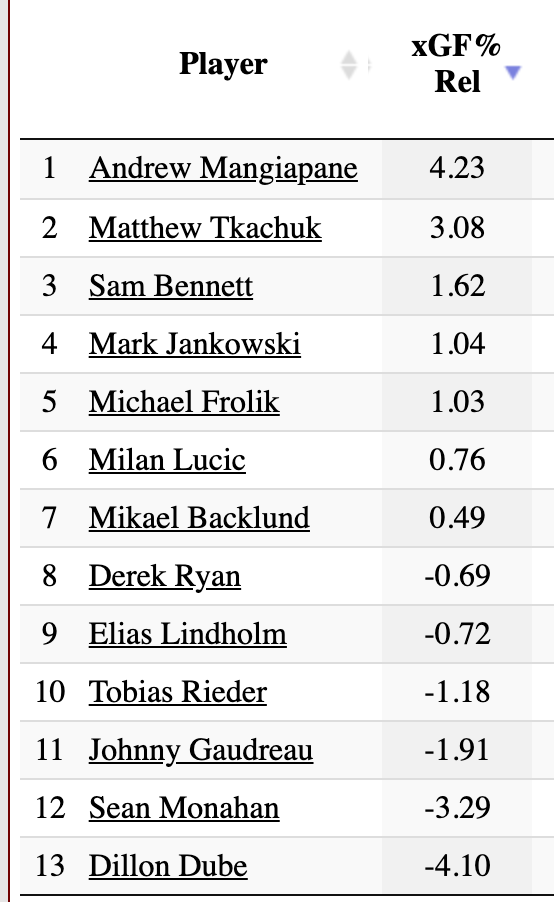
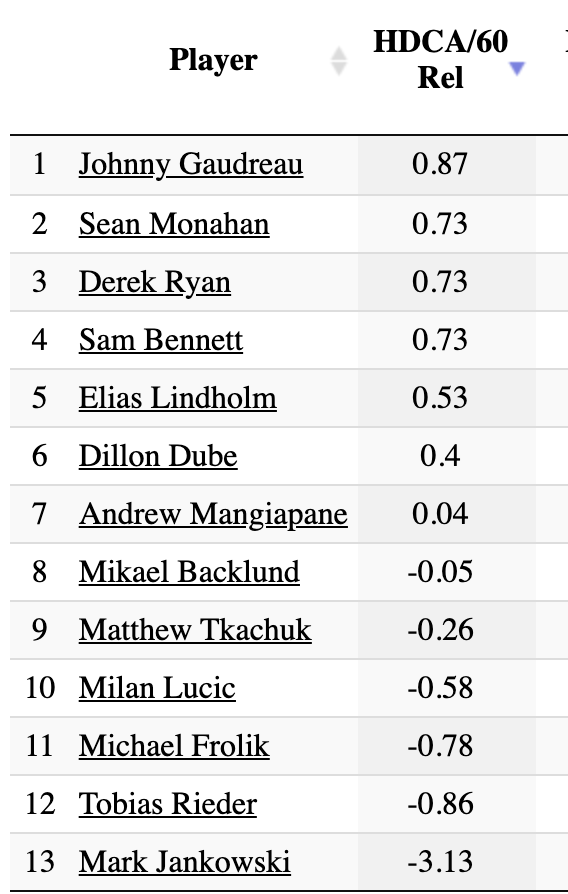


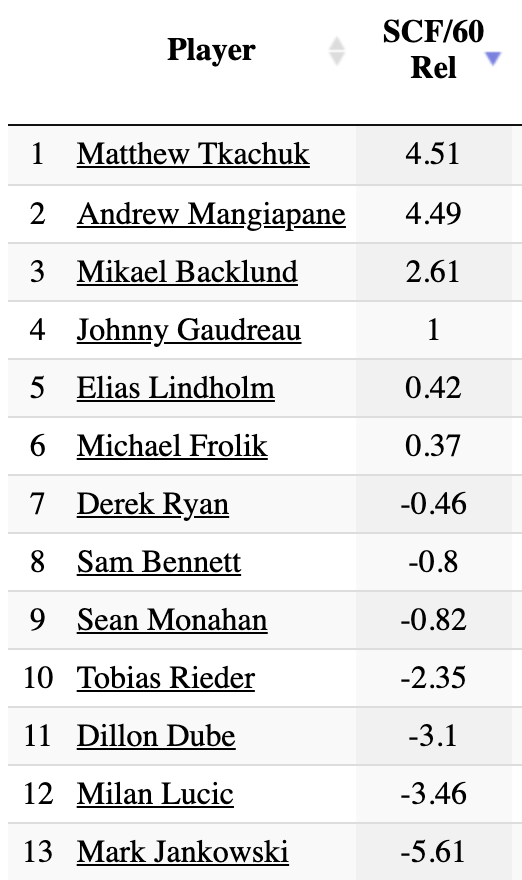
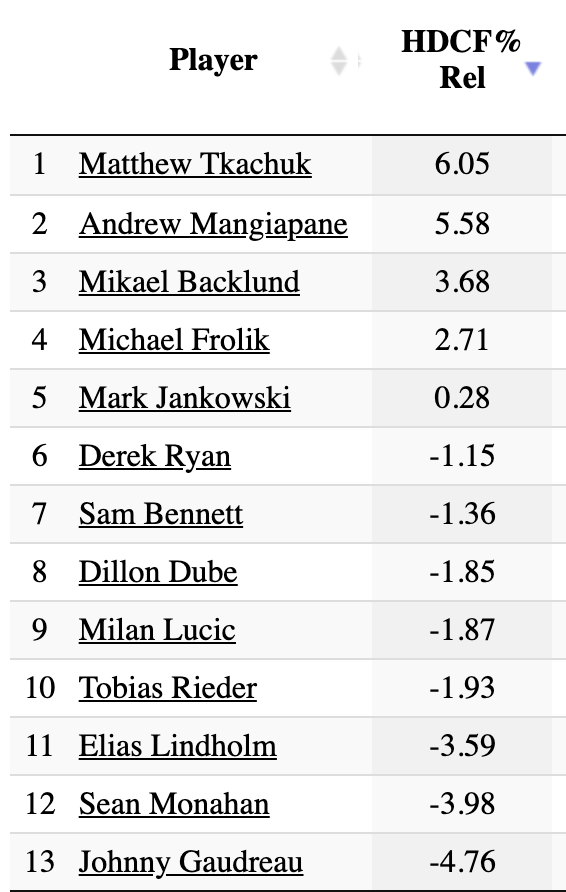



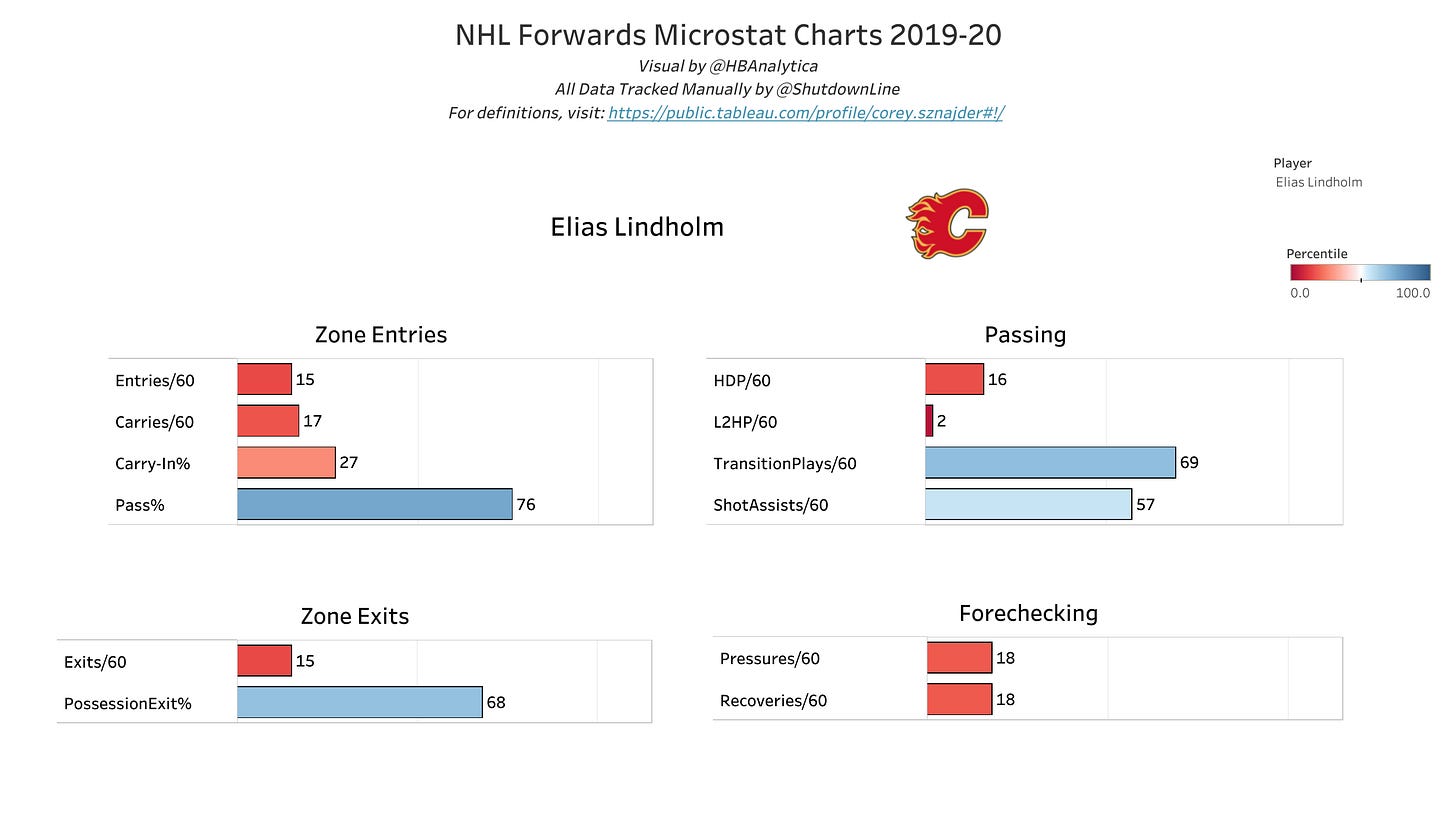







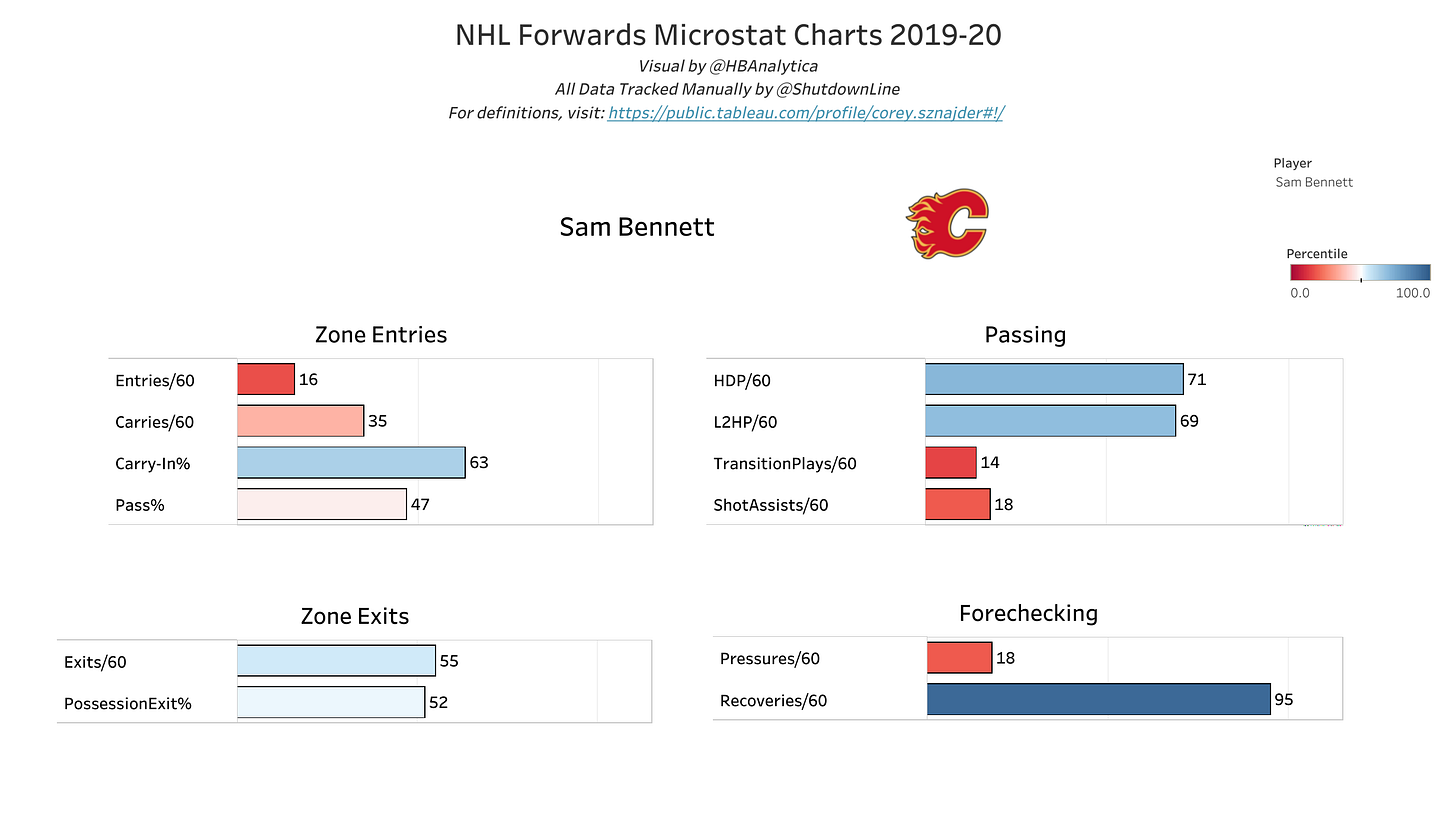
This is the best analysis I have seen by any Flames writer. No one else in the Flames media can take data and make it make sense to the die hard Flames fan. I wish you were still at the Athletic with Darren Haynes. Your guys coverage was outstanding. Keep up the great work!
Now is probably the best time to try Bennett at C with Gaudreau. Bennett attacks the middle of the ice with speed which would help Gaudreau with zone entries, as it would push the defenders off the blueline. Bennett is also capable of gaining the offensive zone himself, making it harder for teams to key on Gaudreau. Bennett can dig pucks out of the corner, if they do need to play dump and chase.
Going into an expansion draft it would also be nice to have some clarity on what exactly Bennett is as an NHL player.
Now I fully understand that there are significant flaws to pairing Gaudreau and Bennett together, but I think a lot of what Bennett does well, fits nicely with trying to open up ice to try and allow Gaudreau to do what he does well.